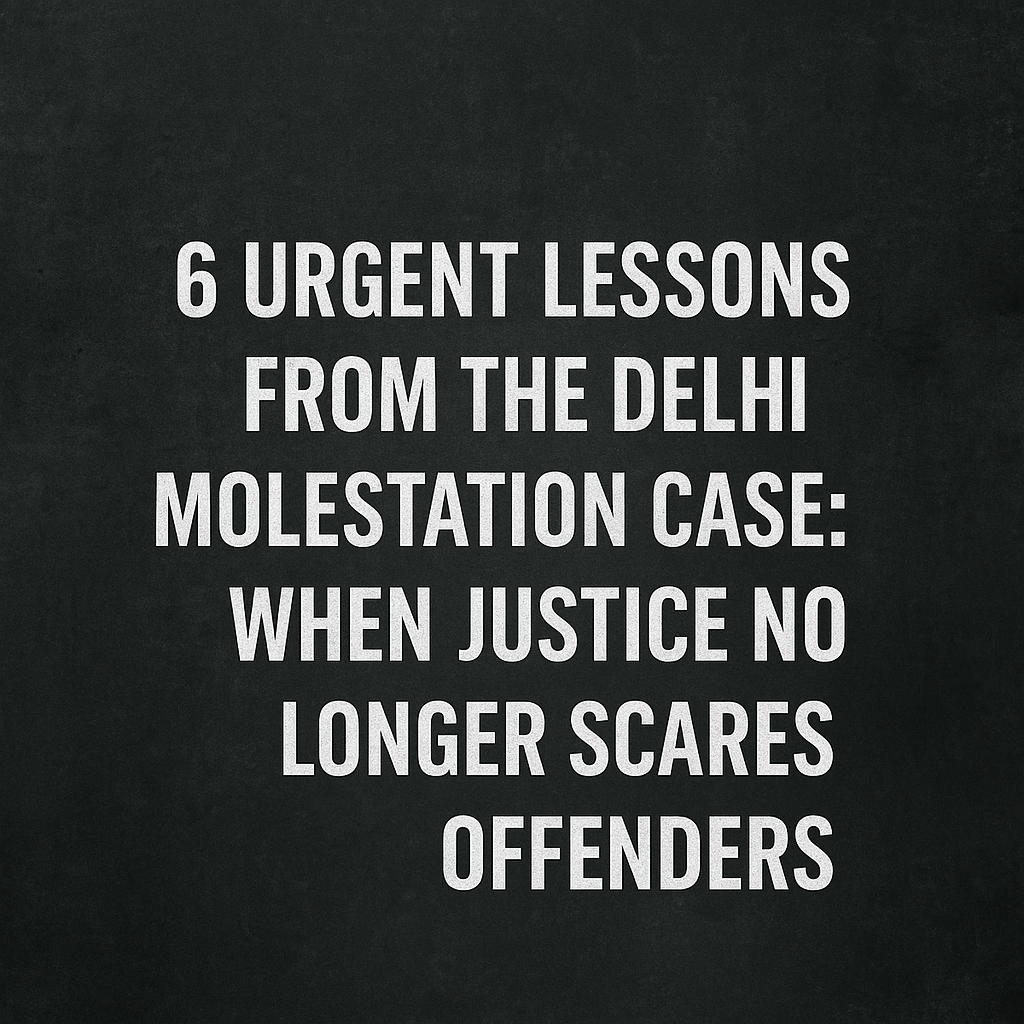
6 Urgent Lessons from the Delhi Molestation Case: When Justice No Longer Scares Offenders
Introduction: When Justice Doesn’t Scare Molestation Offenders Anymore
In a disturbing incident that quickly went viral on social media, a woman from Delhi posted a video of a man who had allegedly molested her. His response was shockingly casual and defiant: “Jail kaat ke aaya hoon, phir chala jaunga” (“I’ve been to jail, I’ll go again”). This bold confession wasn’t whispered in fear—it was spoken on camera, with no hesitation or remorse. The Delhi molestation case has ignited intense public anger and questions about the effectiveness of the justice system and the social structures that allow such attitudes to thrive.
When a molester shows no fear of legal consequences, the issue is no longer just about crime—it’s about a broken deterrence model, societal failure, and normalized deviance. This article delves into the roots of this behavior, explores the impact on victims, and outlines practical solutions to prevent and cure the rot at its core.
The Incident: A Snapshot of Normalized Aggression
The Delhi molestation case isn’t an isolated event—it’s a reflection of a much deeper problem. The woman, who courageously filmed the accused, was met not with apologies or fear, but with bold statements from a man who clearly did not see incarceration as a deterrent.
This statement is chilling for a number of reasons:
- It reflects the normalization of incarceration among certain offenders.
- It reveals how some individuals wear past jail time like a badge of survival or even pride.
- It exposes a dangerous loophole in public safety: when a person has already experienced jail and found it ineffective or tolerable, they are less likely to be deterred from reoffending.
For many women in India, especially in urban areas like Delhi, street harassment and molestation are unfortunate everyday experiences. What made this case more unsettling was the man’s unapologetic confidence. When a molester mocks the legal system, we must ask—how did we get here?
Understanding the Psychology of Fearless Offenders
The Delhi molestation case demands an examination of what drives such brazen behavior. Psychologically, when offenders like this man show no remorse or fear, several dynamics could be at play:
1. Desensitization to Punishment
Repeated exposure to legal proceedings, police stations, and even jails may lead some individuals to become numb to their consequences. Instead of being a space for reform, jail becomes a temporary inconvenience.
2. Social Reinforcement
In many communities, men with criminal pasts are not necessarily shunned. In fact, some are glamorized or seen as “tough” or “masculine.” This reinforcement breeds confidence, not shame.
3. Lack of Empathy
A growing body of research in psychology shows that some repeat offenders, especially those involved in sexual crimes, exhibit traits of antisocial personality disorder—a lack of empathy, disregard for others’ feelings, and a manipulative worldview.
4. Peer Influence and Toxic Masculinity
Men may boast about or downplay their crimes in front of peers to assert dominance. The environment enables aggression and objectifies women, treating molestation as a trivial offense.
Why Justice Isn’t Enough Anymore
Legal mechanisms are necessary, but they are not sufficient. In the Delhi molestation case, the accused was not afraid of being arrested again. This shows that:
- Punishment alone does not rehabilitate unless combined with psychological correction.
- The certainty of punishment is more important than the severity. If a molester believes he can get away with it most times, the one time he’s caught won’t matter.
- Systemic delays and bail loopholes reduce the perceived seriousness of consequences.
The Role of Society: How We Enable Silence
Molestation cases often go unreported due to victim-shaming, slow justice, and lack of support. Even when women do speak up, their trauma is often minimized or questioned. In the Delhi molestation case, the woman’s act of recording the video and sharing it publicly turned the narrative—but not all victims have that platform or courage.
We must address:
- Victim blaming (“Why was she out late?” “What was she wearing?”)
- Family pressure to stay silent due to ‘honor’ or fear of reputation damage.
- Online trolling of survivors who speak up.
Until society starts believing survivors and holding space for them, legal systems will continue to fail.
Prevention: What We Can Do as a Nation
To reduce the frequency and boldness of cases like the Delhi molestation case, prevention must be multi-layered—spanning education, legal reform, social awareness, and urban planning.
1. Gender Education in Schools
Start young. Introduce comprehensive sexuality education that teaches boys and girls about consent, respect, and emotional intelligence.
2. Empowering Bystanders
Create public campaigns that train citizens on how to safely intervene when they witness harassment. Bystander action can prevent crimes in real time.
3. Safer Public Spaces
Ensure well-lit streets, functioning CCTV cameras, and police presence in high-risk zones. Technology can also help, through emergency apps and quick reporting systems.
4. Fast-Track Courts
Reduce legal delays in molestation and harassment cases. Fast-track courts can instill public trust and provide quicker closure for victims.
5. Community Rehabilitation for Offenders
Rather than just sending repeat offenders to jail, introduce mandatory counseling, therapy, and community service. Focus on behavioral change, not just punishment.
6. Workplace and College Sensitization
Mandatory workshops on harassment, consent, and respectful behavior can help create safer environments where accountability is normalized.
Healing After Trauma: How Victims Can Reclaim Power
The emotional aftermath of molestation is often invisible. Survivors experience anxiety, PTSD, depression, and even dissociation. Healing is possible—but it requires systemic support.
1. Trauma Counseling
Mental health professionals play a crucial role in helping survivors process trauma, release guilt, and rebuild self-worth.
2. Support Groups
Spaces where survivors can share without judgment are incredibly powerful. Peer support can accelerate healing and reduce feelings of isolation.
3. Legal Aid and Advocacy
Many victims do not pursue justice due to fear or lack of knowledge. NGOs and legal helplines must bridge this gap with free legal assistance and courtroom support.
4. Art, Writing, and Expression
Therapeutic outlets like journaling, painting, or dance therapy can help survivors regain their sense of agency and identity.
The Role of Media and Technology
The Delhi molestation case gained visibility only because of the woman’s decision to share the video on Instagram. Social media can be a powerful tool when used responsibly:
- Exposing repeat offenders
- Documenting incidents
- Spreading awareness campaigns
- Mobilizing public pressure on authorities
However, it must be used ethically—without endangering victims or creating digital mobs.
What Should Policymakers Do?
- Make sexual harassment laws gender-neutral but survivor-sensitive.
- Invest in gender-sensitive police training.
- Fund rehabilitation programs for at-risk youth to prevent them from turning into offenders.
- Create special task forces for molestation and harassment cases, especially in urban zones.
Conclusion: A Society That Demands Change
The Delhi molestation case is more than a video—it’s a mirror. It reflects a society where a man can molest a woman and casually say he’s ready to return to jail. When fear disappears from the hearts of offenders, it must ignite fire in the hearts of citizens, lawmakers, psychologists, educators, and police officers.
To stop such crimes, we must rebuild from the roots: education, empathy, enforcement, and empowerment. Survivors deserve safety, not silence. And justice must not just punish—it must transform.

